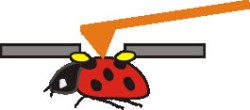May 14 2010
A team of Clarkson University scientists led by Prof. Igor Sokolov are using atomic force microscopy (AFM) to record sounds emanating from inside living insects like flies, mosquitoes and ladybugs.
 Rendering of a ladybug being recorded by the atomic force microscope (AFM) probe.
Rendering of a ladybug being recorded by the atomic force microscope (AFM) probe.
AFM is one of major scientific tools responsible for the emergence of modern nanotechnology.
The unprecedented sensitivity of AFM allowed the Clarkson team to record sub-nano oscillations of very faint amplitude (less than the size of one atom) at high frequencies (up to 1,000 hertz or cycles per second). Previous work in the study of insects was only done at up to 5 hertz. The sounds are recorded by touching the surface of the bugs with an AFM probe.
The study of these sounds may allow researchers to discover unknown features and physiology of insects. Sokolov hopes these discoveries may help in finding solutions to the problems caused by insect pests.
"Insects are of general interest not only as the most numerous and diverse group of animals on the planet, but also as highly efficient bio-machines varying greatly in size," says Sokolov. "Some are major agricultural pests and competitors of humans for crops. Mosquitoes and other insects are important vectors of plant, animal, and human diseases. Also, vast lands of the earth are still underdeveloped because they are occupied by blood-sucking insects."
The team consisted of Sokolov, who has appointments in Physics, and Chemistry and Biomolecular Science; Maxim Dokukin, a physics postdoctoral fellow; and Nataliia Guz, a physics graduate student; and Sergey Vasilyev, instrumental scientist. The other members of Sokolov’s group, physics graduate students Dmytro Volkov, Ravi Gaikwad, and Shyuzhene Li, work on biosensors, self-assembly of particles, and the study of skin aging.
Their research was performed within the Nanoengineering and Biotechnology Laboratories Center (NABLAB), a unit established to promote cross-disciplinary collaborations within the University and led by Sokolov. It comprises more than a dozen faculty members to capitalize on the expertise of Clarkson scholars in the areas of cancer cell research, fine particles for bio and medical applications, synthesis of smart materials, advancement biosensors, etc.